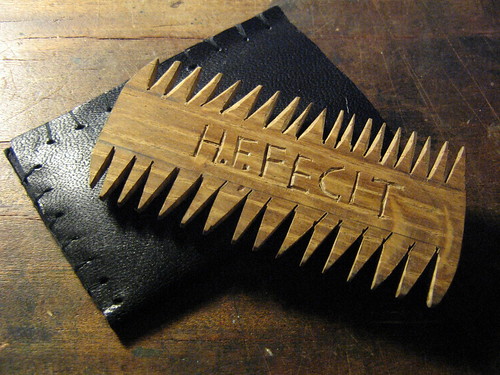
Sunday, November 12, 2006
"Roman" artefacts, part 1
This is a Roman-style comb that I made, for 'hands-on' experience and for acting out Minimus plays. It's made of boxwood and the teeth are (very badly) cut out with a handsaw. The case is leather, like Lepidina's. It's part of a collection of stuff I keep in my classroom. There's a wax tablet, a couple of bits of wood veneer to show how thin the Vindolanda tablets were, a roll of papyrus from the local art shop and a few other bits and pieces. More photos later (I am trying to finish the artwork for the Italian edition of Minimus!)


Sunday, October 15, 2006
Corvus the crow
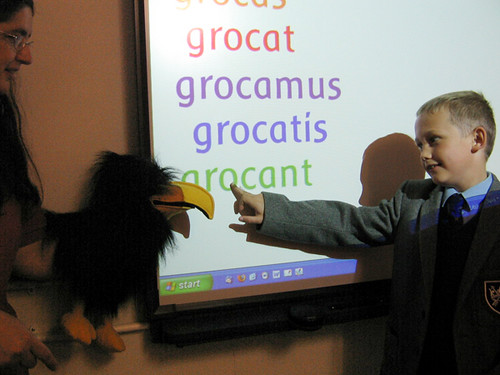
Corvus the Latin-speaking crow has been meeting Form V, who are learning their present tense verb endings with animal noises. He can hold a whiteboard pen pretty well, but his mouse control isn't up to much.
Tuesday, September 26, 2006
Odysseus mural... gone but not forgotten
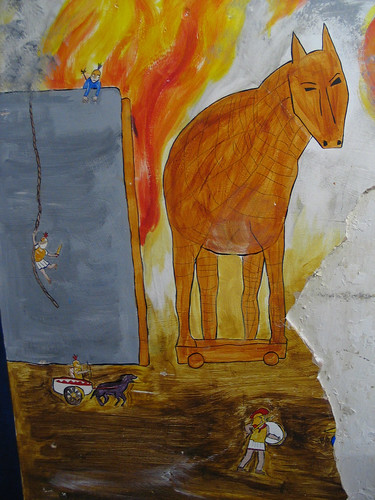
Way back in the nineties, when I was first teaching, we painted the story of Odysseus' journey onto the library wall. This year it disappeared under fresh paint and new shelves, but it deserves its moment in public.
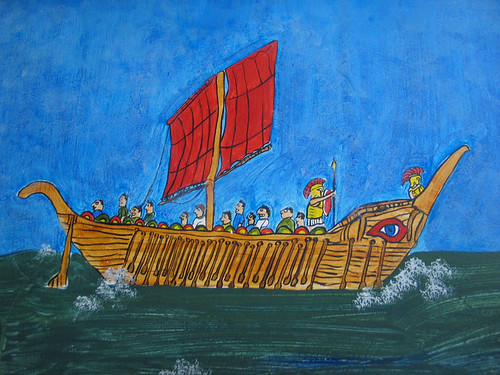
Every child in the Prep school at the time contributed at least one drawing. Some children responded with a flow of lively characters and details - others needed persuasion, more persuasion and sinister threats... but everyone was represented in the final composition.
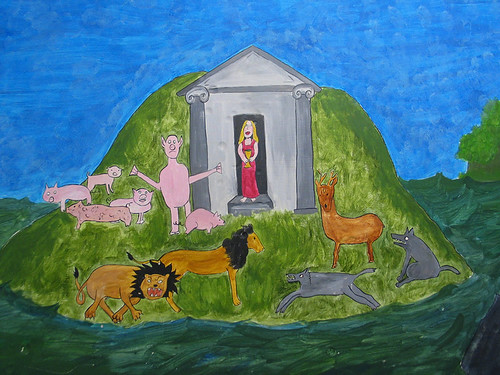
Then I spent a lot of time with tracing paper and the school photocopier, making all the images the right size, before putting them on the wall with carbon paper (carbon paper - I haven't seen any for years!) We had to fit the composition to the shape of the wall, which was a rectangle with a door cut out in the middle.

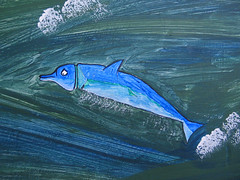
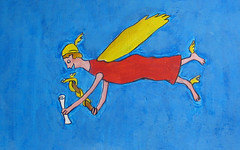
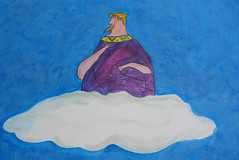
The wall had been re-plastered and had a coat of nice fresh emulsion. This was before the damp bits appeared... The painting was all done with acrylics, the flow formula type, with glaze and matt media to thin the colours. Then I added the black outlines with Indian ink.
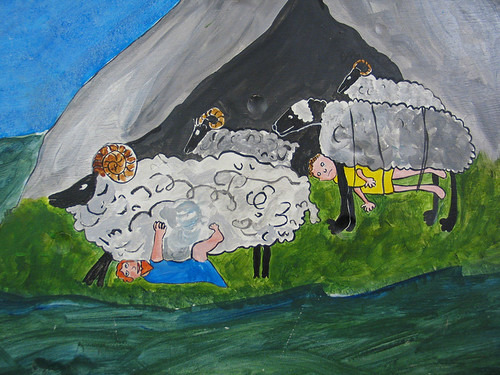
Sunday, September 03, 2006
The Archaeology Box
This is the fourth time we've tried the hands-on archaeology experiment, finding out how different materials are affected by being buried underground for months. The first time, we couldn't find one of the burial sites at all. The next time, we flagged the buried box too well and it was disturbed by person or persons unknown (or possibly the school dog!). This time, we dug a really deep hole and recorded how far it was from the classroom window!
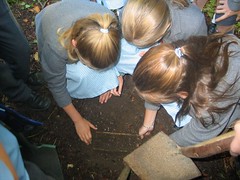
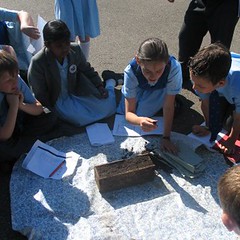
We used a small, unlidded wooden box. This is what we put in:
A conker
A piece of candle wax
A thin slip of wood, as thin as the Vindolanda tablets
A piece of paper
A piece of toast
A stainless steel knife
A glass bead
A piece of glazed china
A tiny glass bottle
A feather
A piece of copper foil
A lead weight from a curtain
A 2p coin and a 5p coin
A cow's tooth
A flint
A cork
This is what the stuff looked like when we dug it up in July!
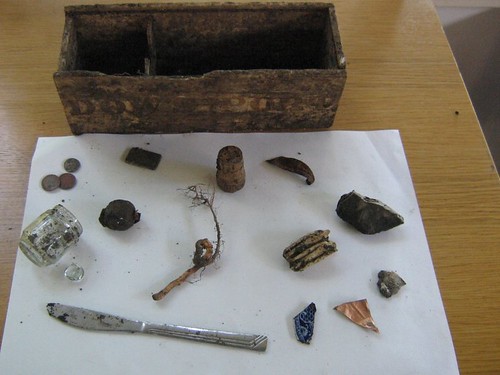


We used a small, unlidded wooden box. This is what we put in:
A conker
A piece of candle wax
A thin slip of wood, as thin as the Vindolanda tablets
A piece of paper
A piece of toast
A stainless steel knife
A glass bead
A piece of glazed china
A tiny glass bottle
A feather
A piece of copper foil
A lead weight from a curtain
A 2p coin and a 5p coin
A cow's tooth
A flint
A cork
This is what the stuff looked like when we dug it up in July!

Sunday, July 30, 2006
Papier Mache Roman Coins

Another of our rather-longer-term projects was Coin-Making, held up by all sorts of technical difficulties in the process. It took all year (well, to be honest, the casts spent months shoved into a cupboard in frustration after the great Plasticine Disaster) but we managed to turn out some display-worthy pieces in the end. The children were Year 5 when they started this project.
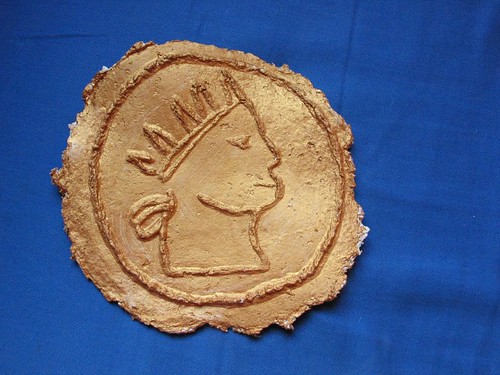
We started by planning the coins on paper, and drawing them about 15 cm in diameter. We put our coin drawings under acetate sheets, but those plastic pocket things would work just as well.
Then we made flat plasticine designs on the acetate. (Next time: use coloured plasticine, not white!) The most successful designs were well flattened, and had no undercut bits. The children used pen tops, brush handles and cocktail sticks to impress patterns and writing on their mouldings.
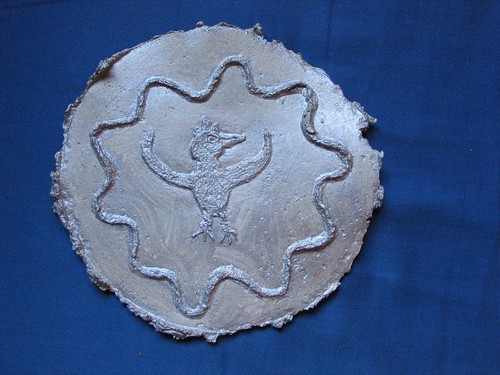
Next, we made long flat strips about an inch wide and built a circular wall round the coin design. Then I mixed plaster of Paris (not all at once, I think we did two or three coins at a time) and poured it into the wall. If you thump the table a couple of times, the bubbles leave and the top surface smooths out. The stuff takes an hour of so to dry properly. This is my here-is-one-I-made-earlier cast:
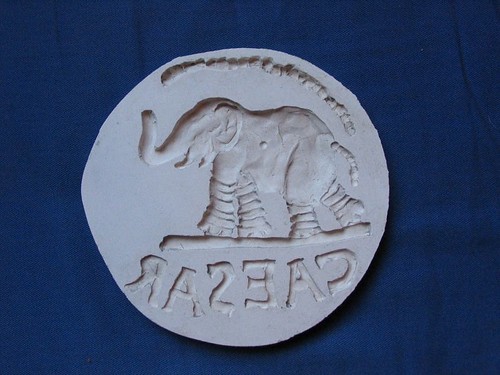
The easy part was done. Now we had to dig the plasticine out from the cast. This was where we regretted the white plasticine, as it looked just like the wretched plaster. I trimmed up any little overhangs where the liquid plaster had seeped under the plasticine. Then we had to grease the moulds with Vaseline and an old brush.

We used the sort of papier mache that comes powdery and dry in a bag, and looks like tuna mayonnaise when you add water. We filled the moulds and made the coins about 0.5 cm thick. The stuff took a few days to dry but if you try to take the coins out too soon, the design part will not be dried hard and may break up.
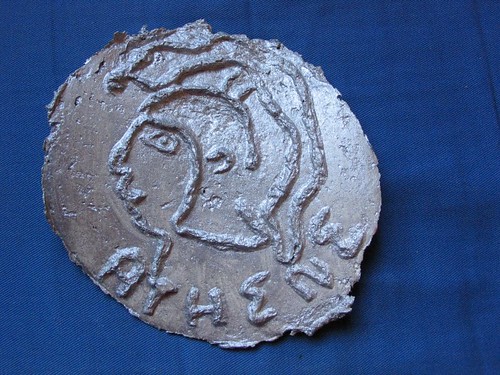
The coins were painted with Berol 'Meltdown' paint, which is water soluble but needs about three coats to look solid. They'll be going on the walls next term.
The coins here were made by Issie, Hetty, Eleanor and Ellie
Sunday, July 23, 2006
Boudicca!
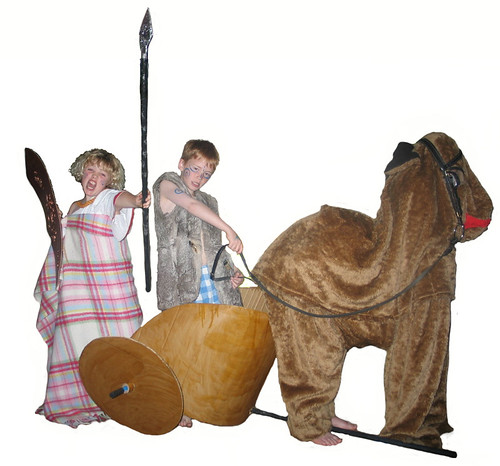 Our Year 4 children performed an assembly about Boudicca right at the end of term (not that anyone had anything else to think about that week...). Most of the Iceni were in checky PJ bottoms and blue face paint (but I'm not going to post any pictures of topless gentlemen) and the Romans in my red T-shirts. The children made their own Celtic shields. The horse is a Moreton Hall classic of great antiquity, as it was the first costume I made. Which explains why it looks more like a camel. The front half looked particularly impressive singing along to 'Onward Christian soldiers' with its big red mouth. I am particularly proud of the chariot which would have run along the stage properly if the horse's bottom had remembered to pick up the pole. The axle is a mop handle and the thing itself is cardboard painted with wood varnish. There isn't any bottom to it.
Our Year 4 children performed an assembly about Boudicca right at the end of term (not that anyone had anything else to think about that week...). Most of the Iceni were in checky PJ bottoms and blue face paint (but I'm not going to post any pictures of topless gentlemen) and the Romans in my red T-shirts. The children made their own Celtic shields. The horse is a Moreton Hall classic of great antiquity, as it was the first costume I made. Which explains why it looks more like a camel. The front half looked particularly impressive singing along to 'Onward Christian soldiers' with its big red mouth. I am particularly proud of the chariot which would have run along the stage properly if the horse's bottom had remembered to pick up the pole. The axle is a mop handle and the thing itself is cardboard painted with wood varnish. There isn't any bottom to it.The Roman soldiers' helmets and shields were made by pupils a few years back (I need to make a new set, I think!). They were very proud of themselves, because they managed to say all their lines in Latin ("eheu! Boudicca saeva est! timeo" "sed Boudicca femina est. Romani feminas non timent!")

Saturday, June 03, 2006
Myths With Recycled Barbies
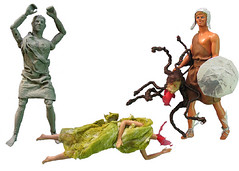
As I teach everyone Latin, Art and ICT, it was a natural and irresistible move to make mythological scenes and take digital photos of them. Our Art room lay figure, Bob, would happily dress up for us, but I decided it would be easier to work with small figuresThe children have been generous in donating obsolete dolls, and I have picked up a few in charity shops and car boot sales. So far we have done the abduction of Helen, Daphne and Apollo and Medusa. We haven’t been violent on purpose; we did cover cheap-knockoff-Action Man in PVA and sand, but it will soak off, and the head falling off Medusa was an accident that happened when I was trying to sew a brunette wig on the thing’s scalp. What a pity.
Wednesday, May 24, 2006
The second of our stand-against-the-wall-of-sickbay videos, filmed as a series of short clips with a Canon G5 on a not very stable tripod and re-dubbed later to cover up the background noise and my ever more desperate instructions (You're off stage! Hit him now! Go on, die!) The script was written to fit with Chapter 8 of Minimus, where Flavius visits the doctor, and the 'Doctor, doctor!' exercises in the teacher's book. No children were actually damaged during the making of the film (although there were times...)
Powered by Castpost
Powered by Castpost
Wednesday, May 17, 2006
Powered by Castpost
Monday, May 15, 2006
Minimus bloggere incipit...
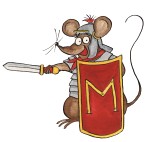
salvete omnes! Minimus and I are venturing from the safe haven of our website into the scary outer space of the blogosphere. I hope that Minimus readers and website visitors will leave the odd comment, as it's very easy to do. I also hope that I can set up Minimus podcasts and streaming video (never say I don't have aspirations far beyond my actual abilities...)
I should be able to keep people updated on developments in the Minimus world - and there are a lot of pots boiling at once, such as the Italian edition and a growing collection of teachers' resources.
valete,
Dr F
Subscribe to:
Posts (Atom)
